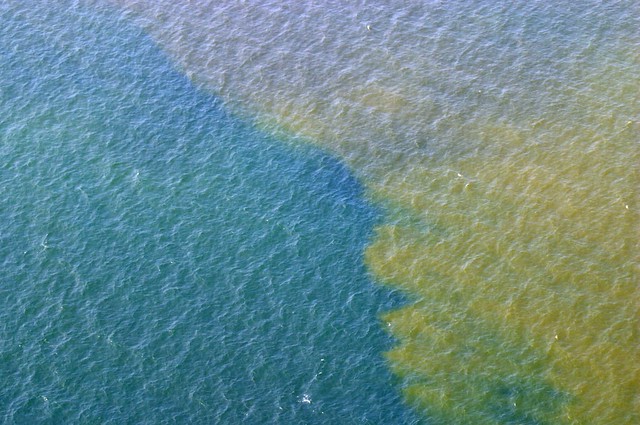
Karenia brevis bloom offshore of Pinellas County. Photo credit: Florida Fish and Wildlife Conservation Commission
In recent years, harmful algal blooms, or HABs, have wreaked havoc in Florida’s inland and coastal waters. Blooms, which are an overabundance of algae, can create toxins that harm aquatic life and cause health problems in humans and pets. When the blooms die, their decomposition lowers oxygen levels in the water further impacting fish and other wildlife.
In August, Florida Sea Grant and University of Florida’s Institute of Food and Agricultural Sciences convened a meeting of more than 70 HABs experts at the U.S. Geological Survey offices in St. Petersburg to discuss the state of research on HABs in Florida.
The UF/IFAS Florida Sea Grant Harmful Algal Bloom State of the Science Symposium brought together researchers from around the state and across the country to discuss what is known about HABs, especially Karenia brevis red tide and Microcystis aeruginosa cyanobacteria — two main HABs impacting the state. The group was tasked with assessing the current state of the science and prioritizing research needs in the areas of:
- Initiation, development and termination of blooms
- Prediction and modeling
- Detection and monitoring
- Mitigation and control
- Public health
“We got a really fantastic group of state and national key players in this field together to discuss the science,” said Lisa Krimsky, a Florida Sea Grant extension agent and one of the symposium chairs. “Researchers and state and federal agency representatives from nine other states joined Florida’s scientists to discuss this pressing issue.”
A secondary function of the event was for researchers to meet or reconnect. “We hope this will result in more collaborative projects moving forward,” noted Betty Staugler, Florida Sea Grant extension agent and the other event chair.
The symposium was dedicated to the late Karl Havens, Florida Sea Grant director from 2007-2019, who was a leading aquatic ecologist, a member of the symposium steering committee, and a driving force behind efforts to address HABs in the state.
After two days of presentations and heated debate, researchers identified current areas of knowledge, data gaps and areas of uncertainty, as well as short- and long-term research priorities.
A summary document of scientific consensus statements and research priorities is being developed from the symposium to inform Florida’s Harmful Algal Bloom and Blue-Green Algae Task Forces and to facilitate better public outreach and communication from the scientific community.
To learn more about these and other efforts to address harmful algal blooms in Florida, visit: archive.flseagrant.org/HABs.



